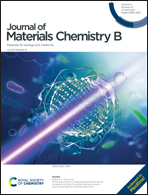Active colorimetric lipid-coated polyaniline nanoparticles for redox state sensing in cancer cells†
Abstract
Herein, lipid-coated polyaniline (LiPAni) nanoparticles were fabricated to monitor the redox state of cancer cells. To confirm the characteristics of LiPAni, we firstly analyzed the size and chemical structures of the LiPAni nanoparticles. The absorbance properties of the LiPAni nanoparticles were observed to vary with the pH conditions. Furthermore, cell viability tests conducted with breast cancer cell lines showed that the cell viability of the cells with LiPAni nanoparticles was dramatically increased compared to those with the Tween80-coated polyaniline nanoparticles (TPAni) as a control. Subsequently, the colors of the LiPAni nanoparticles were observed and analyzed using spectroscopic methods. Finally, in order to investigate the more accurate sensing of the redox state using the color changes of the LiPAni nanoparticles with cancer cell lines, dark field microscopic images and scattering spectra were recorded at the single nanoparticle scale. For the TPAni nanoparticles, there was only a change in brightness and no change in color, but for the LiPAni nanoparticles, there was a change of color from yellow to pink in the dark field images.



 Please wait while we load your content...
Please wait while we load your content...